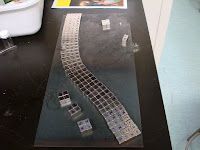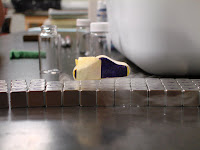As we near the end of the RET, we have been finalizing certain aspects of the project. We had initially intended to make a track that was an oval, which the vehicle could circumnavigate. However, that was a bit impractical because the magnets are quite expensive, and funding an entire oval would cost about $1200. As it is, Ram was quite generous and we have nearly $500 worth of magnets as our track. Not being able to construct a complete track, we fashioned the magnets into the shape of California.
We kept the track with four-wide magnets, with alternating poles (N-S-N-S). At the place where San Francisco would be, we removed two of the "coastal" magnets. Since the pellets will move stably over three-wide magnets, the vehicles can navigate through the "bay" with ease. Below is a bit of the evolution of the California track. We have painted the base (magnetic stainless steel) to help show it as California. The blocks of magnets on the side are the Channel Islands, complete with polarity arrangements to allow pellets to head out to the islands and "just hang out." I think that could be a nice educational tool, because it will be easier to see how stable the pellets are, and the smaller magnetic base might be easier to explain than the entire track.




